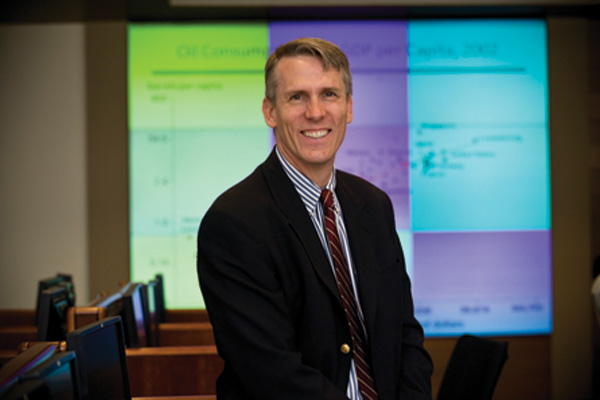
With a grant from the National Science Foundation, Geoff Parker plans to set up internal knowledge markets at Bank of America and the Securities and Exchange Commission.
Geoff Parker has studied platforms—business networks that connect two or more distinct user groups—for more than a decade, but this fall he and his colleagues plan to take that research to another level with an investigation of how firms can use one type of platform—an internal knowledge market—to drive and distribute innovation.
The project is part of a $700,000 National Science Foundation grant that Parker, associate professor of economic sciences, and colleagues Marshall Van Alstyne and Edward Anderson received last fall to study platform-driven innovation within firms and across firms. This year they plan to launch one of the first initiatives of their proposal—setting up knowledge markets at organizations including Bank of America and the Securities and Exchange Commission.
“If you take the idea of a platform and combine that with outsourcing knowledge work, we have a way of harnessing more distributed effort,” Parker says. “We think that’s really cool.”
Over the last two decades, many companies have set up knowledge management systems to try to capture innovations developed by employees and distribute those innovations to other users within the company, but the results have generally been poor. One reason for that, Parker says, is the lack of incentive for employees to use the system.
“Most people are measured on their personal output, not on the degree to which they enable somebody who could be on the other side of the world to get their work done faster,” Parker says. “There just isn’t an incentive mechanism, particularly in a large corporation, that is set up to do that.”
For this project, Parker and his colleagues are building a software-based platform that will create a market to “price” internal knowledge based on its value to users in the company and give the originator of that knowledge a royalty based on its reuse. For example, if an IBM engineer develops a component that can be used by other engineers at the company, he or she can upload a description of the component and let others bid on it to determine its value. The more useful the component is to other employees, the higher the price it will yield in the internal market. The market’s currency will be points rather than dollars, but users of the system will be able exchange points for things of value, such as vacations or prizes such as iPads.
By analyzing the way employees use the knowledge market, Parker and his colleagues hope to learn more about how to set up the right incentives to ensure that knowledge users, knowledge providers and the company get value from the system.
Parker says the research team plans to conduct trials with students at Tulane and Boston University this year, and then launch the markets at participating companies next year. He hopes to have a data set to analyze by 2012.
“We don’t think anyone’s done anything like this before,” Parker says. “We’re going to get micro-level data and we’re going to intervene and we’re going to run experiments and we’re going to see how the system responds. That’s science, and that’s why the National Science Foundation is funding it.”
